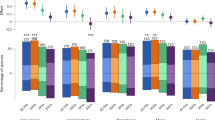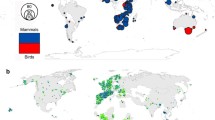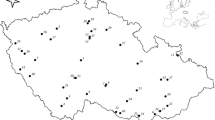Abstract
An effective portfolio of protected areas should, all else being equal, give rise to positive relationships between the amount of protected land in a region and the numbers of species present. Tests of this prediction are, however, extremely scarce, and most do not control for the potentially confounding effects of environmental factors that influence broad geographic trends in biodiversity. Here, we document the form of the relationship between species richness and coverage by protected areas using the British avifauna as a case study. We contrast relationships that arise for breeding and wintering assemblages, considering both all species collectively and threatened species only. We use spatially explicit multiple regression analyses that take into account environmental factors previously shown to exert a marked influence on avian species richness in Britain (temperature and altitude). Avian species richness and the amount of protected land are consistently positively correlated with each other, and the slopes of these relationships do not differ between assemblages (breeding/wintering and all species/threatened species). Explanatory power is, however, very weak which may be indicative of the ability of conservation measures in the wider landscape to maintain avian species richness, reducing any distinctive influence of protected areas.
Similar content being viewed by others
References
Armesto JJ, Rozzi R, Smith-Ramirez C, Arroyo MTK (1998) Conservation targets in South American temperate forests. Science 282:1271–1272. doi:10.1126/science.282.5392.1271
Baillie SR, Marchant JH, Crick HQP, Noble DG, Balmer DE, Barimore C, Coombes RH, Downie IS, Freeman SN, Joys AC, Leech DI, Raven MJ, Robinson RA, Thewlis RM (2007) Breeding birds in the wider countryside: their conservation status 2006. BTO research report No. 470. BTO, Thetford
Barrow E, Hulme M, Jiang T (1993) A 1961–90 baseline climatology and future climatic change scenarios for Great Britain and Europe. Part 1: 1961–90 Great Britain baseline climatology. University of East Anglia Climatic Research Unit, Norwich
Burnham KP, Anderson DR (2001) Kullback-Leibler information as a basis for strong inference in ecological studies. Wildl Res 28:111–119. doi:10.1071/WR99107
Burnham KP, Anderson DR (2002) Model selection and multimodel inference: a practical information-theoretical approach. Springer-Verlag, New York
Chown SL, Rodrigues ASL, Gremmen NJM, Gaston KJ (2001) World heritage status and conservation of southern ocean islands. Conserv Biol 15:550–557. doi:10.1046/j.1523-1739.2001.015003550.x
Deguise IE, Kerr JT (2006) Protected areas and prospects for endangered species conservation in Canada. Conserv Biol 20:48–55
Donald PF, Greenwood JJD (2001) Spatial patterns of range contraction in British breeding birds. Ibis 143:593–601
Evans KL, Greenwood JJD, Gaston KJ (2005) Dissecting the species–energy relationship. Proc R Soc Biol Sci Ser B 272:2155–2163
Evans KL, Rodrigues ASL, Chown SL, Gaston KJ (2006) Protected areas and regional avian species richness in South Africa. Biol Lett 2:184–188
Evans KL, Greenwood JJD, Gaston KJ (2007a) The positive correlation between avian species richness and human population density in Britain is not attributable to sampling bias. Glob Ecol Biogeogr 16:300–304
Evans KL, Lennon JJ, Gaston KJ (2007b) Slopes of avian species–area relationships, human population density, and environmental factors. Avian Conserv and Ecol 2:7
Gaston KJ, Blackburn TM (2000) Pattern and process in macroecology. Blackwell Science Ltd., Oxford
Gaston KJ, Blackburn TM, Greenwood JJD, Gregory RD, Quinn RM, Lawton JH (2000) Abundance–occupancy relationships. J Appl Ecol 37(Suppl 1):39–59
Gaston KJ, Charman K, Jackson SF, Armsworth PR, Bonn A, Briers RA, Callaghan CSQ, Catchpole R, Hopkins J, Kunin WE, Latham J, Opdam P, Stoneman R, Stroud DA, Tratt R (2006) The ecological effectiveness of protected areas: the United Kingdom. Biol Conserv 132:76–87
Gaston KJ, Jackson SF, Cantú-Salazar L, Cruz-Piñón G (2008a) The ecological performance of protected areas. Annu Rev Ecol Evol Syst 39:93–113
Gaston KJ, Jackson SF, Nagy A, Cantú-Salazar L, Johnson M (2008b) Protected areas in Europe: principle and practice. Ann NY Acad Sci 1134:97–119
Gibbons DW, Reid JB, Chapman RA (1993) The new atlas of breeding birds in Britain and Ireland: 1988–1991. BTO/SWC/IWC. T. & A. D. Poyser, London
Gregory RD, Wilkinson NI, Noble DG, Robinson RA, Brown AF, Hughes J, Procter DA, Gibbons DW, Galbraith CA (2002) The population status of birds in the United Kingdom, Channel Islands and Isle of Man: an analysis of conservation concern 2002–2007. Br Birds 95:410–450
Hunter ML Jr, Yonzon P (1993) Altitudinal distributions of birds, mammals, people, forests, and parks in Nepal. Conserv Biol 7:420–423
Jackson SF, Gaston KJ (2008) Incorporating public and private land in conservation planning: the ecological effectiveness of protected areas in Britain. Ecol Appl 18:1050–1060
Kerr JT, Burkey TV (2002) Endemism, diversity, and the threat of tropical moist forest extinctions. Biodivers Conserv 11:695–704
Kleijn D, Baquero RA, Clough Y, Díaz M, Esteban J, Fernández F, Gabriel D, Herzog F, Holzschuh A, Jöhl R, Knop E, Kruess A, Marshall EJP, Steffan-Dewenter I, Tscharntke T, Verhulst J, West TM, Yela JL (2006) Mixed biodiversity benefits of agri-environment schemes in five European countries. Ecol Lett 9:243–254
Lack P (1986) The atlas of wintering bird in Britain and Ireland BTO/IWC. T. & A. D. Poyser, London
Lan D, Dunbar R (2000) Bird and mammal conservation in Gaoligongshan Region and Jingdong County, Yunnan, China: patterns of species richness and nature reserves. Oryx 34:275–286
Legendre P, Dale MRT, Fortin MJ, Gurevitch J, Hohn M, Myers D (2002) The consequences of spatial structure for design and analysis of ecological field surveys. Ecography 25:601–615
Lennon JJ, Greenwood JJD, Turner JRG (2000) Bird diversity and environmental gradients in Britain: a test of the species-energy hypothesis. J Anim Ecol 69:581–598
Lennon JJ, Koleff P, Greenwood JJD, Gaston KJ (2001) The geographical structure of British bird distributions: diversity, spatial turnover and scale. J Anim Ecol 70:966–979
Littell RC, Milliken GA, Stroup WW, Wolfinger RD (1996) SAS® system for mixed models. SAS Institute Inc., Cary
Margules CR, Nicholls AO, Usher MB (1994) Apparent species turnover, probability of extinction and the selection of nature reserves: a case study of the ingleborough limestone pavements. Conserv Biol 8:398–409
Peach WJ, Lovett LJ, Wotton SR, Jeffs C (2001) Countryside stewardship delivers cirl buntings (Emberiza cirlus) in Devon, UK. Biol Conserv 101:361–373
Potts SG, Bradbury RB, Mortimer SR, Woodcock BA (2006) Commentary on Kleijn et al. Ecol Lett 9:254–256
Prendergast JR, Quinn RM, Lawton JH, Eversham BC, Gibbons DW (1993) Rare species, the coincidence of diversity hotpsots and conservation strategies. Nature 365:335–337
Quinn GP, Keough MJ (2002) Experimental design and data analysis for biologists. Cambridge University Press, Cambridge
Rackham O (1986) The history of the countryside. Dent, London
Rodrigues ASL, Andelman SJ, Bakarr MI, Boitani L, Brooks TM, Cowling RM, Fishpool LDC, da Fonseca GAB, Gaston KJ, Hoffmann M, Long JS, Marquet PA, Pilgrim JD, Pressey RL, Schipper J, Sechrest W, Stuart SN, Underhill LG, Waller RW, Watts MEJ, Yan X (2004) Effectiveness of the global protected area network in representing species diversity. Nature 428:640–643
Thiollay J-M (2006) The decline of raptors in West Africa: long-term assessment and the role of protected areas. Ibis 148:240–254
UN (1992) Convention on biological diversity—United Nations conference on environment and development. Rio de Janeiro, Brazil
Verboom J, Foppen R, Chardon P, Opdam P, Luttikhuizen P (2001) Introducing the key patch approach for habitat networks with persistent populations: an example for marshland birds. Biol Conserv 100:89–91
Vickery JA, Bradbury RB, Henderson IG, Eaton MA, Grice PV (2004) The role of agri-environment schemes and farm management practices in reversing the decline of farmland birds in England. Biol Conserv 119:19–39
Webb TJ, Noble D, Freckleton RP (2007) Abundance-occupancy dynamics in a human dominated environment: linking interspecific and intraspecific trends in British farmland and woodland birds. J Anim Ecol 76:123–134
Whittingham MJ, Stephens PA, Bradbury RB, Freckleton RP (2006) Why do we still use stepwise modelling in ecology and behaviour? J Anim Ecol 75:1182–1189
Williams PH, Gaston KJ (1998) Biodiversity indicators: graphical techniques, smoothing and searching for what makes relationships work. Ecography 21:551–560
Acknowledgments
We thank the numerous volunteers who collected the avian data, the British Trust for Ornithology for making them available, and the Joint Nature Conservancy Council on behalf of Natural England, Scottish Natural Heritage, and the Countryside Council for Wales for making available the data on statutory protected areas. Particular thanks go to J.J.D. Greenwood for invaluable advice and discussion. K.J.G. holds a Royal Society-Wolfson Research Merit Award. This work was supported by the The Leverhulme Trust, and the UK Population Biology Network (UKPopNet), funded by the Natural Environment Research Council (Agreement R8-H12-01) and Natural England.
Author information
Authors and Affiliations
Corresponding author
Electronic supplementary material
Below is the link to the electronic supplementary material.
Rights and permissions
About this article
Cite this article
Jackson, S.F., Evans, K.L. & Gaston, K.J. Statutory protected areas and avian species richness in Britain. Biodivers Conserv 18, 2143–2151 (2009). https://doi.org/10.1007/s10531-009-9578-6
Received:
Accepted:
Published:
Issue Date:
DOI: https://doi.org/10.1007/s10531-009-9578-6




